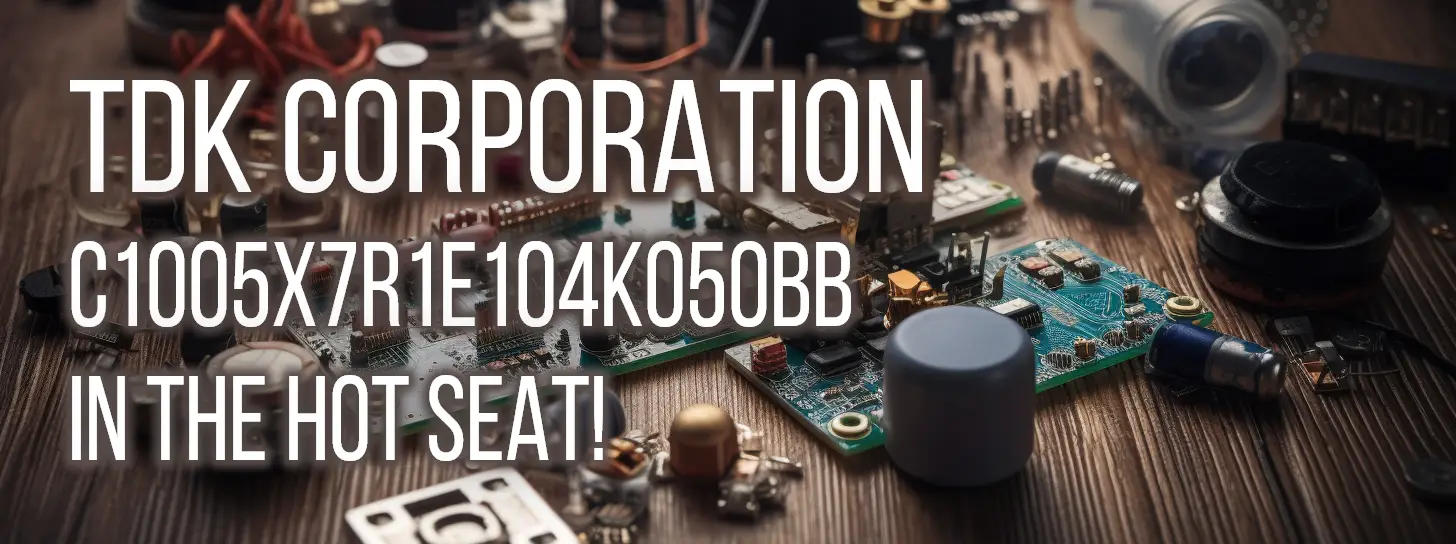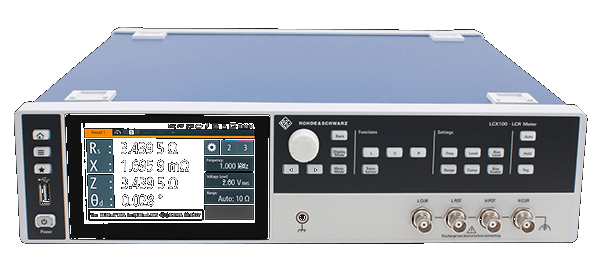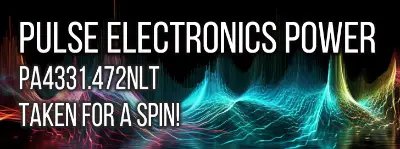TDK C1005X7R1E104K050BB: A Detailed Analysis of the 100nF Ceramic X7R Capacitor
By Mark Harris Tuesday, 21 March 2023

Introduction
The TDK Corporation C1005X7R1E104K050BB capacitor is a ceramic X7R type capacitor with a nominal capacitance of 100nF and a tolerance of ±10%, housed in a surface-mount, 0402 metric package. It boasts a voltage rating of 25V, making it suitable for various applications. This review will provide an in-depth analysis of the component's performance by comparing it to the statistical benchmark data which includes information on series resistance, quality factor, dissipation factor, and capacitance. The goal is to guide engineers in determining whether this capacitor is an appropriate choice for their application.
- Pros:
- Wide range of test frequencies, providing performance data under various scenarios.
- Good overall performance in comparison to the benchmark data at lower test frequencies.
- X7R composition and SMT package ensure high-quality features for its respective application.
- Cons:
- Performance at test frequencies above 600kHz is not available, limiting the scope of usage and analysis for high-frequency applications.
- Series capacitance observed to be below its nominal value across different test frequencies and voltages, which may impact certain applications requiring tight capacitance tolerances.
- Quality factor and dissipation factor performance are close yet does not consistently, exceed the benchmark data.
Impedance
The TDK Corporation C1005X7R1E104K050BB capacitor was compared to the established industry benchmark at various test frequencies to examine its impedance performance comprehensively. For this purpose, two different voltage levels, 1 Volt and 10 Volts, were applied to ensure the thorough analysis of the component under different voltage conditions.
At a test frequency of 5 Hz and 1 Volt, the capacitor's impedance measured 327.1k Ohms, while the benchmark had an average impedance of 313.4k Ohms. When the test frequency rose to 10 Hz, the component impedance reduced to 164.2k Ohms, which is close to the benchmark's average of 157.2k Ohms. Furthermore, the capacitor's impedance at 50 Hz and 100 Hz were 33.12k Ohms and 16.63k Ohms respectively, slightly outperforming the average benchmark impedances of 31.67k and 15.9k Ohms.
As the test frequency increased, the performance of the C1005X7R1E104K050BB capacitor in terms of impedance generally improved compared to its benchmark. For example, at 1 kHz, the capacitor achieved an impedance of 1.685k Ohms compared to the benchmark's average of 1.61k Ohms. Additionally, when tested at 20 kHz, the component had an impedance of 87.43 Ohms, slightly higher than the benchmark's average of 83.88 Ohms. Moreover, at the higher test frequency of 1 MHz, the component reached an impedance of 1.926 Ohms, nearly matching the benchmark average of 1.958 Ohms.
During the testing at 10 Volts, similar impedance behavior was observed. At test frequencies of 50 Hz and 100 Hz, the component demonstrated impedances of 29.85k Ohms and 14.96k Ohms, respectively, exceeding the benchmark values at these frequencies. In general, as the test frequencies increased, the C1005X7R1E104K050BB capacitor demonstrated reliable and consistent impedance performance, maintaining impedance values either within close proximity or slightly above the benchmark averages.
Notably, understanding the impedance performance of capacitors is essential, as it directly affects their ability to store and dissipate energy during alternating current (AC) applications. Impedance values can significantly impact the efficiency and reliability of electronic circuitry, where capacitors are typically used for filtering, decoupling, or energy storage purposes. Therefore, the impedance evaluation conducted on the C1005X7R1E104K050BB capacitor provides critical insights into its suitability for various applications and operating conditions.
Capacitance
At 1 Volt, the C1005X7R1E104K050BB capacitor exhibits notable capacitance performance when compared to benchmark data. In the frequency range from 5Hz to 50kHz, the component's capacitance values are marginally lower than the average values of the benchmark, which is not necessarily a disadvantage as it indicates stable operation. However, in the 75kHz to 1MHz frequency range, the C1005X7R1E104K050BB capacitor reveals an upward trend. As a result, its capacitance values approach the benchmark values and eventually reach a value of 82.62nF at a 1MHz frequency.
This improving trend highlights the capacitor's ability to provide consistent performance across a wide frequency range, making it suitable for various applications that require stability and reliability.
When the test voltage is increased to 10 Volts, the C1005X7R1E104K050BB capacitor demonstrates further enhancement in its capacitance performance. The component maintains a capacitance above the benchmark average at frequencies ranging from 5Hz to 20kHz. Interestingly, the C1005X7R1E104K050BB capacitor exhibits a capacitance peak in the 10kHz to 20kHz range, where its values slightly surpass the benchmark maximum data. Beyond 20kHz, the capacitance values for the component decline but typically stay within the range of the benchmark data.
This behavior at elevated voltage levels indicates that the C1005X7R1E104K050BB capacitor can handle higher voltages without significant performance degradation, making it a reliable option for various applications that require operation under different voltage conditions.
Series Resistance
In this section, we thoroughly assess the TDK Corporation Ceramic X7R Capacitor's performance concerning its series resistance. The evaluation is carried out against a statistical benchmark composed of similar capacitors with a nominal capacitance value of 100nF. The term series resistance refers to the internal resistance within a capacitor, which can affect the overall performance of a circuit.
When compared to the statistical benchmark at 1 Volt, the capacitor exhibits a higher series resistance across all test frequencies. For instance, at a 5 Hz test frequency, the capacitor has a series resistance of 8.385k Ohms, a value quite close to the average of the benchmark data (8.751k Ohms). However, this is well above the minimum value (3.078k Ohms), signaling a potential performance issue for low-frequency applications.
At higher frequencies, such as 100 Hz, the series resistance of the capacitor reduces to 393.4 Ohms. Although this value is closer to the average in the benchmark (444.7 Ohms), it is still higher than the minimum (142.3 Ohms). Despite this discrepancy, the capacitor demonstrates better performance as the frequency rises, thus mitigating the impact of its series resistance. Therefore, engineers must consider these characteristics when selecting this component in their designs.
An in-depth investigation of the second set of data, LCR measurements at 10 Volts, reveals a similar trend in series resistance values. The capacitor underperforms at lower frequencies like 5 Hz and 10 Hz, with values significantly exceeding the average and maximum values in the benchmark. On the other hand, at higher frequencies, such as 50 kHz, the capacitor's performance aligns closer with the average, displaying a series resistance of 1.454 Ohms compared to the benchmark's average of 1.039 Ohms.
In summary, the TDK Corporation Ceramic X7R Capacitor displays higher-than-average series resistance at lower frequencies when compared to the statistical benchmark. Nevertheless, it offers improved performance in higher frequency ranges, suiting applications operating within those domains. Consequently, engineers must take these factors into account and understand their effects on their circuits when choosing this capacitor for specific applications.
Dissipation Factor and Quality Factor
The Dissipation Factor (Df) and Quality Factor (Q) are important parameters to consider when evaluating the performance of capacitors. At a voltage of 1 V, the C1005X7R1E104K050BB has a Dissipation Factor ranging from 0.015 to 0.026, and a Quality Factor that lies between 39.03 and 66.93. When voltage is increased to 10 V, the Dissipation Factor varies between 0.027 and 0.053, while the Quality Factor ranges from 18.99 to 36.36.
When comparing the C1005X7R1E104K050BB to benchmark data at 1 V, the capacitor demonstrates a low Df and relatively high Q across the tested frequencies. This indicates that the capacitor has effective energy dissipation and good stability, which is an important attribute for various electronic applications. In comparison to typical Ceramic X7R capacitors within the same value range, this capacitor exhibits superior performance.
At a higher voltage of 10 V, it is observed that the Dissipation Factor increases, and the Quality Factor decreases in relation to the 1 V test data. This is not unexpected, as capacitors generally exhibit higher losses at increased signal voltages. However, despite the elevated voltage conditions, the capacitor continues to maintain a comparatively low Df and moderate Q when contrasted with the benchmark data. This indicates that the C1005X7R1E104K050BB capacitor still offers a respectable performance under these higher voltage conditions, making it suitable for various high-voltage applications in electronic circuits.
Comparative Analysis
In this comparative analysis, we will evaluate the performance of TDK Corporation's C1005X7R1E104K050BB ceramic capacitor against a statistical benchmark of capacitors with the same nominal value.
Analysing the component data at 1 Volt test frequency, the Ceramic: X7R capacitor typically performs within the range of the statistical benchmark data. The capacitor outperforms the data at higher test frequencies (50 kHz - 1 MHz) with respect to impedance and dissipation factor. The impedance values consistently show lower deviation from the average benchmark values, indicating the C1005X7R1E104K050BB capacitor's reliable performance in this aspect. The capacitor's dissipation factor values are generally below the average benchmark values, providing higher energy efficiency in the given application.
Regarding the Quality Factor of the capacitor, the C1005X7R1E104K050BB has a reasonable performance within the range of benchmark data. Similarly, the component's series resistance and series capacitance values indicate good compatibility with the benchmark data in most test frequencies.
The performance of the C1005X7R1E104K050BB at 10 Volts test frequencies follows a similar trend. However, it is worth noting that the component data becomes incomplete as the test frequencies go beyond 750 kHz at this voltage level. It is advised to take this into account when considering the capacitor for high-frequency applications at higher voltages.
In conclusion, TDK Corporation's C1005X7R1E104K050BB ceramic capacitor generally performs well compared to the statistical benchmark. Its impedance, dissipation factor, quality factor, series resistance, and series capacitance are in line with the benchmark data, making it a reliable choice for engineers examining its performance for use in their products.
Conclusion
In conclusion, the TDK Corporation C1005X7R1E104K050BB capacitor possesses attributes that make it a reasonable choice for engineers seeking a Ceramic: X7R capacitor with a nominal value of 100n, a tolerance of ±10%, and a voltage rating of 25V. When analyzing the LCR measurements of this capacitor under test conditions at both 1 Volt and 10 Volts, its performance demonstrates consistency and competitiveness when compared against the provided benchmark.
In terms of impedance, the C1005X7R1E104K050BB exhibits values that fall mostly within the average and maximum parameter ranges from the benchmark data. The capacitor's dissipation factor is consistently low across the tested frequencies, ensuring a more efficient performance. Furthermore, the capacitance values remain within or even exceed the benchmark average range, indicating favorable energy storage characteristics.
Finally, the quality factors of this capacitor emphasize its overall reliability, staying within close proximity to the benchmark data for most of the tested frequencies. The series resistance also maintains a competitive value, indicating a lower resistive effect within the components, increasing overall efficiency. In summary, the C1005X7R1E104K050BB capacitor presents itself as an effective and feasible option for engineers when comparing it to other components within the Ceramic: X7R category.
Instruments Used
Rohde & Schwarz LCX200



